Seven Elements of a Beautiful Garden
 Sunday, May 3, 2015 at 5:01AM
Sunday, May 3, 2015 at 5:01AM What makes a beautiful garden? What is it that halts our feet and makes us stand in wonder rather than walk through with a passing glance? I have made my list, based on my own observations and prejudices.
#1. Variety of color, shape and texture
Color catches our attention!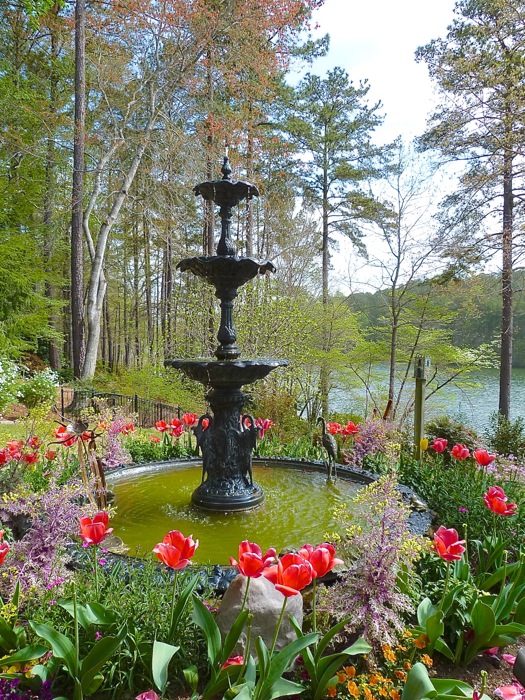 This fountain, in the garden of Eddie Aldridge, is beautiful, but the color around it makes it a show-stopper.But remember, green is a color, too, and there are about fifty shades of green and innumerable variegations.
This fountain, in the garden of Eddie Aldridge, is beautiful, but the color around it makes it a show-stopper.But remember, green is a color, too, and there are about fifty shades of green and innumerable variegations. One can have a green garden that is just as lovely in its own way as that of a multihued field of tulips.
One can have a green garden that is just as lovely in its own way as that of a multihued field of tulips.Hills and Dales Estate in Lagrange, Georgia, has a primarily green garden.One should also pay attention to shape and texture, particularly if one color is dominant in a garden. If all the leaves in a green garden are the same size and shape, the effect will be boring. The same is true of texture, which refers to the feel of the surface. Don't we love to reach out and stroke a furry plant like lamb's ear? Don't we admire thick, shiny leaves? That furry plant or those thick shiny leaves may be a perfect counterpoint to a plant with lacy foliage.
#2. Layers
Layering plants is another way of introducing variety into a garden.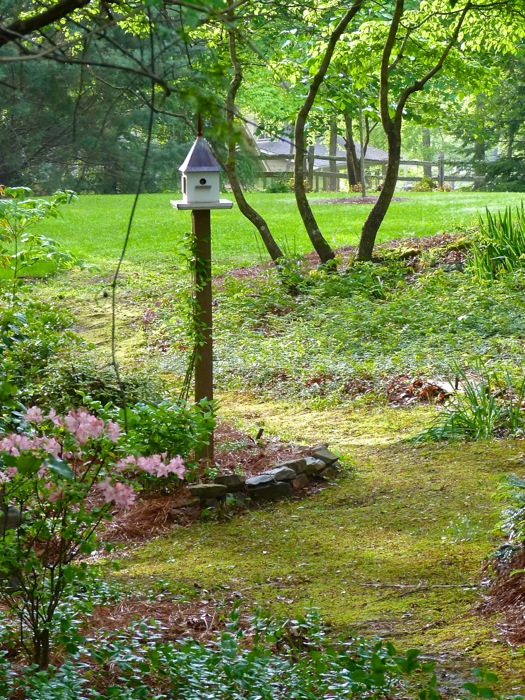 Plants are layered in my woodland garden to create interest and beauty.Gardens that are all on the same level do not have nearly as much interest as gardens that extend from the ground upward. One sees this in a woodland with its canopy of taller trees and understory of smaller trees. Beneath these are shrubs, and then closer to the ground are perennials and annuals. Ground covers provide the lowest level. One can introduce layers into a garden even if one does not have trees. An arbor can give a vine a chance to climb. A basket of flowers can hang from a tall shepherd's hook or a fern can hang from the eve of a house, drawing the eye upward. A table can raise pots of flowers off the ground.
Plants are layered in my woodland garden to create interest and beauty.Gardens that are all on the same level do not have nearly as much interest as gardens that extend from the ground upward. One sees this in a woodland with its canopy of taller trees and understory of smaller trees. Beneath these are shrubs, and then closer to the ground are perennials and annuals. Ground covers provide the lowest level. One can introduce layers into a garden even if one does not have trees. An arbor can give a vine a chance to climb. A basket of flowers can hang from a tall shepherd's hook or a fern can hang from the eve of a house, drawing the eye upward. A table can raise pots of flowers off the ground.
#3. Abundance
Gardens should have enthusiasm! A few flowers are nice, but a thousand flowers are breathtaking. I have never counted my daffodils, but there must be at least a thousand!A garden should have spirit; it should reach and drape, stretch and push boundaries.
I have never counted my daffodils, but there must be at least a thousand!A garden should have spirit; it should reach and drape, stretch and push boundaries.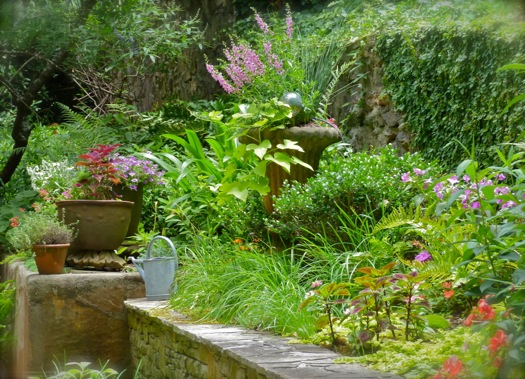 I like the exuberance of plantings in this Homewood, Alabama garden.It may even be a little messy, but I am not talking about neglect. If it looks almost out of control, it is because the gardener intends it to be so.
I like the exuberance of plantings in this Homewood, Alabama garden.It may even be a little messy, but I am not talking about neglect. If it looks almost out of control, it is because the gardener intends it to be so.
#4. Movement
This means a garden pulls us in; our eyes move from place to place in the garden. One creates movement by repetition of color, form and shape. 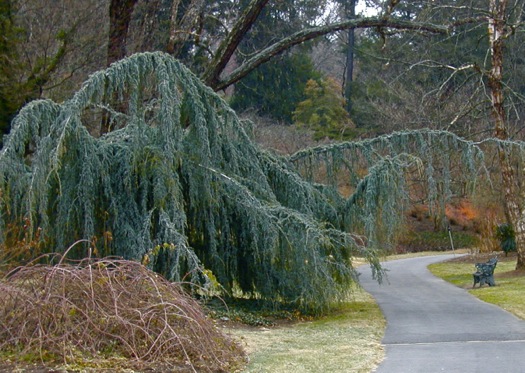 The curve of the path repeats the curve of the magnificent weeping Blue Atlas Cedar, which is echoed by the shrub below it. Note how the bench repeats the color in the tree. All these elements pull the eye forward and create movement in this section of the garden at Biltmore Estate in Asheville, North Carolina.Using the same plant in different parts of the garden is an easy way to do this, but there are other ways. The color of a swath of flowers may repeat the color in the leaves of a shrub. The curve of a garden path may repeat the arch of a tree limb or the shape of a planting bed. Paths are a wonderful way to connect different parts of the garden and will always create a feeling of movement.
The curve of the path repeats the curve of the magnificent weeping Blue Atlas Cedar, which is echoed by the shrub below it. Note how the bench repeats the color in the tree. All these elements pull the eye forward and create movement in this section of the garden at Biltmore Estate in Asheville, North Carolina.Using the same plant in different parts of the garden is an easy way to do this, but there are other ways. The color of a swath of flowers may repeat the color in the leaves of a shrub. The curve of a garden path may repeat the arch of a tree limb or the shape of a planting bed. Paths are a wonderful way to connect different parts of the garden and will always create a feeling of movement. 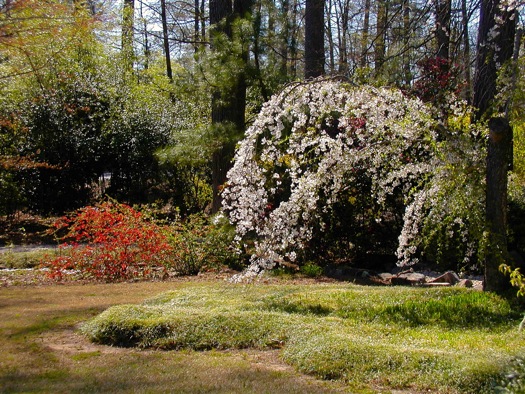 Here is another example of creating movement in the garden. This scene is in the Japanese Garden at the Birmingham Botanical Gardens.
Here is another example of creating movement in the garden. This scene is in the Japanese Garden at the Birmingham Botanical Gardens.
#5. Focal Points
A focal point is a center of interest. I once heard a woman complaining that people did not appreciate her garden. She defended her design by saying it was full of native plants. She did not recognize that her garden lacked a focal point. A visitor's eyes wandered across the space with no place to rest. It all looked much the same. A path leading to a bench would have been a huge improvement, and a birdbath would have been a welcome addition. Imagine this scene in my front garden without the birdhouse. A focal point makes all the difference!A focal point can be almost anything. It can be an art object or a beautifully shaped pot.
Imagine this scene in my front garden without the birdhouse. A focal point makes all the difference!A focal point can be almost anything. It can be an art object or a beautifully shaped pot.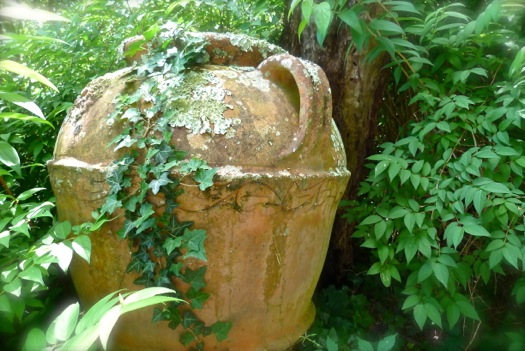 This pot at Jasmine Hill Gardens, near Wetumpka, Alabama, immediately caught my attention.It can be a fabulous specimen plant.
This pot at Jasmine Hill Gardens, near Wetumpka, Alabama, immediately caught my attention.It can be a fabulous specimen plant.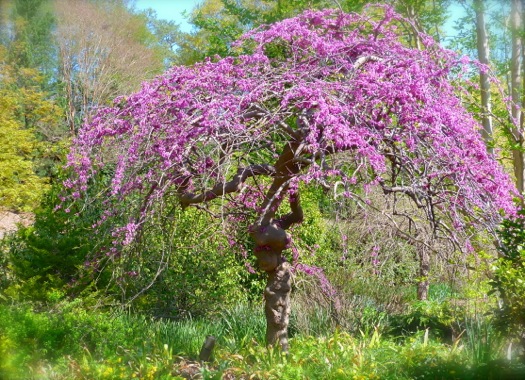 This weeping redbud tree at the Atlanta Botanical Gardens is a wonderful focal point.It can be a structure such as a garden shed or an arbor. A large garden may have several focal points; but beware: if there are too many, they may all lose their focus!
This weeping redbud tree at the Atlanta Botanical Gardens is a wonderful focal point.It can be a structure such as a garden shed or an arbor. A large garden may have several focal points; but beware: if there are too many, they may all lose their focus!
#6. Enclosure
Beautiful gardens have boundaries. Enclosures may be defined by hardscape or vegetation. For example, an area may be enclosed within a picket fence or a low stone wall, or there may be rooms with screens made of hedges. Such an enclosure would be a great space to add a bench or other place to sit so one may admire the garden. This courtyard at Jasmine Hill Gardens is enclosed by a stone wall and lovely plantings.A small romantic alcove may be surrounded by roses. The edge of a large garden may be marked by a row of trees. Maybe these boundaries give us a feeling of security; or perhaps they impart a sense of mystery, because don't we all want to know what is on the other side of a wall!
This courtyard at Jasmine Hill Gardens is enclosed by a stone wall and lovely plantings.A small romantic alcove may be surrounded by roses. The edge of a large garden may be marked by a row of trees. Maybe these boundaries give us a feeling of security; or perhaps they impart a sense of mystery, because don't we all want to know what is on the other side of a wall!
#7. Wildlife
A beautiful garden is a healthy garden, and healthy gardens are filled with wildlife. As we walk through a garden, we delight in the whirr of a hummingbird or the flutter of a butterfly. We may laugh at the antics of a squirrel or smile when we hear a mockingbird. A beautiful garden is a noisy place, with all manner of chirps and calls, chatters and buzzing. There are myriads of bugs. Remember, over ninety percent of bugs are good guys. Our gardens need those bugs, so we should not be quick to nuke-em all, as is the approach of some. Wildlife is deeply interconnected with the health of the garden, and what is good for wildlife is also good for us. Creatures like these always make a stroll in my garden pleasurable.
Creatures like these always make a stroll in my garden pleasurable.